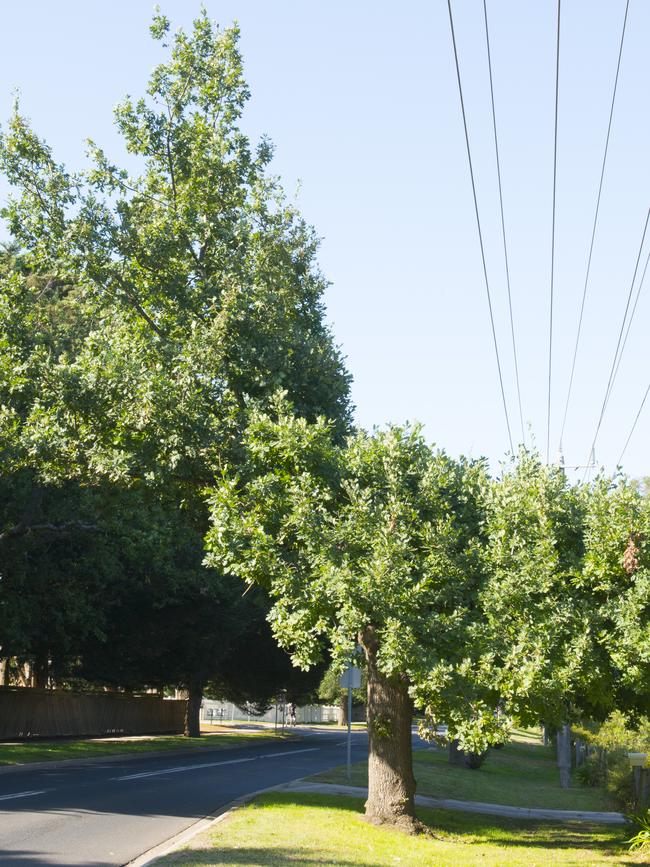Gardening: Finding the balance with trees’ beauty and powerline safety
Imagine finding this sight in your street. There must be a kinder cut when it comes to preserving nature’s beauty and also ensuring human safety, says Tony Fawcett.
I LOVE my trees.
That’s the reason I was so distraught last week upon seeing several beautiful old exotic trees with their foliage hearts seemingly hacked out.
My immediate reaction was outrage.
In this age of growing environmental awareness, how could anyone commit such vandalism on such beautiful specimens?
What madness!
One poor old oak had been so cruelly treated as to have had two-thirds of its limbs cut away, leaving it horribly lopsided.
What possible reason could there be for such butchery?
Now, some wise old person — likely a lawyer — once observed you should never ask a question like that without knowing the answer.

Yes, I secretly knew the answer, and it became clearer once I calmed down from my outrage.
It was about safety and dollars.
These magnificent old trees are in an avenue of oaks and elms in a close-to-Melbourne countrified area, revered for its village-like beauty. They had grown so big they were endangering power lines above.
One heavy wind could bring down limbs, cutting power to neighbouring areas, enraging electricity customers, maybe even — God forbid — sparking a bushfire.
While the 2009 Victorian Bushfires Royal Commission after the disastrous Black Saturday tragedy recommended the mass undergrounding of powerlines for fire mitigation reasons, these trees it seemed had been excluded, despite in some areas being reasonably close to bush and open farmland.
Likely, local bureaucrats and power company boffins — anxious to avoid electricity hikes to customers (not good for the image in the current climate) while meeting strict safety codes of practice for electricity line clearance — had opted for super heavy pruning by their contractors in preference to expensive undergrounding of power cables.
Somehow aesthetics or the question of which came first, the trees or the power lines, didn’t seem to matter.
Now I don’t seek to be critical of local authorities and power companies and their contractors; they have an at times difficult job to do. But I think as gardeners, as appreciators of botanical beauty, we need to confront such issues, and make our thoughts known.
We need to work out as a community what value we put on, say, 60- to 100-year or even older oaks, elms and the like.
Certainly while I was photographing those forlorn looking trees several passers-by stopped to share their sense of grief.
I’m well aware, too, that similarly distressing situations exist across the state.
Looking at it objectively, large-growing trees like these should not be grown as roadside plantings. Far better is that they be restricted to open spaces where they can thrive unfettered and un-hacked.
This is how most councils seem to view it today — and in our own gardens most of us are aware of the need to match a tree’s mature growth to available space. Yet despite all this commonsense, I still can’t help thinking exceptions need to be made.
Where such magnificent, mature trees like these already exist in not ideal spaces, I believe we have a responsibility as a society to consider their beauty more before reaching for the chainsaw. They need to be treated as exceptional, because they are exceptional.
MORE GARDENING
BLOOMING TREE CHANGE TO ADD COLOUR
I was taken by a quote from a resident of a nearby area to this where last year trees were “butchered”. She observed that the combined age of the four workers doing the “mutilating” of one tree was less than that of the tree itself.
Sometimes I fear that in a place that once prided itself as being the “Garden State” we lose sight of true botanical beauty and its intrinsic worth.
American writer and poet Alfred Joyce Kilmer famously wrote, “I think that I shall never see a poem lovely as a tree.”
I reckon Kilmer would see neither rhyme nor reason in the despoiling of the forlorn trees I saw the other day.


